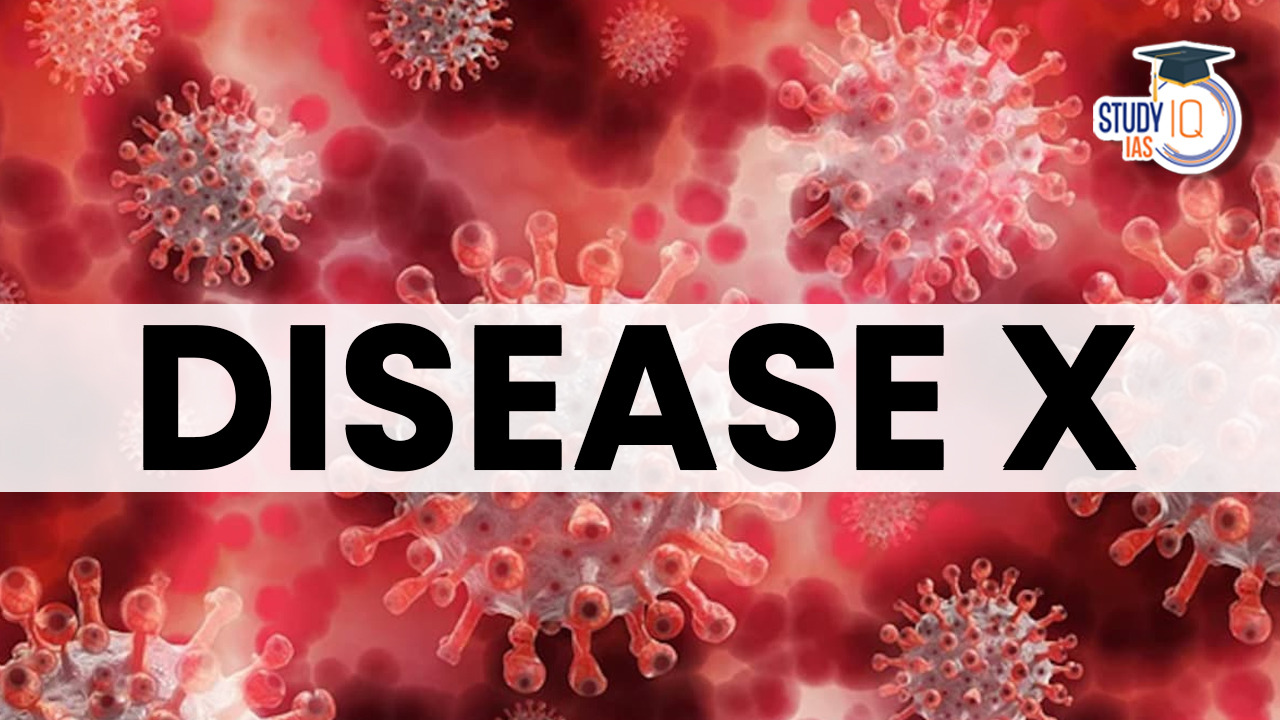Table of Contents
The unclassified outbreak in the Democratic Republic of Congo (DRC), with over 400 deaths, has raised concerns about Disease X becoming a reality.
In recent times, the world has witnessed the havoc that infectious diseases can wreak on society. With the emergence of COVID-19, a global pandemic that continues to affect millions, the importance of vigilance and preparedness against potential future threats cannot be overstated. One such threat that health experts are keeping a close eye on is known as “Disease X.” In this article, you will get all about the Disease X Pandemic in India its Symptoms, Reasons and Preparedness in future.
What is Disease X Pandemic?
- Disease X represents a hypothetical, yet highly probable, global health threat.
- Pathogen X could include viruses, bacteria, parasites, fungi, helminths or prions.
- The term was coined by the World Health Organization (WHO) in 2018, the term is a placeholder for any unknown pathogen capable of causing a devastating epidemic or pandemic.
Historical Patterns
- Since 1940, over 300 emerging infectious diseases have been identified, with 70% of them having zoonotic origins (transmitted from animals to humans).
- Deforestation, urbanisation and climate change push humans and wildlife into closer contact, increasing zoonotic spillover risks.
Examples of Past Emerging Diseases
HIV, SARS, MERS and Ebola: All emerged due to ecological disruptions and human activity.
WHO’s Priority List of Pathogens
- It includes diseases like Ebola, Marburg, Nipah and Disease X.
- This list aims to direct global research, funding and policy efforts toward combating high-risk diseases with limited medical countermeasures.
Preparing for Disease X
- Surveillance Systems: Use genomic sequencing and real-time data sharing for early outbreak detection.
- Healthcare Infrastructure: Strengthen healthcare systems in low- and middle-income countries to improve outbreak response.
- Research Investments: Coalition for Epidemic Preparedness Innovations (CEPI) is developing platforms to create vaccines within 100 days of outbreak detection.
- Global Frameworks: Expanding frameworks like the Nagoya Protocol to include biological materials such as pathogens can ensure fair and equitable access to research findings and medical solutions.
What is the next virus pandemic?
Scientists’ warnings echo the WHO’s prediction of an “inevitable” Disease X pandemic, a term coined in 2018 before COVID-19. The WHO’s “Blueprint list of priority diseases” highlights potential threats like Ebola, SARS, and Zika. Disease X represents the anticipation that a severe global epidemic could emerge from a pathogen not yet known to affect humans, often zoonotic like Ebola, HIV/AIDS, and COVID-19. This underscores the importance of preparedness and research to mitigate future pandemics and underscores the unpredictable nature of infectious diseases.
Read about: National Digital Health Mission
WHO’s Stance on Disease X Pandemic
The World Health Organization (WHO) has acknowledged the concept of Disease X as a hypothetical but serious concern. “Disease X” stands for the unexpected outbreak that scientists and public health experts fear could lead to a global health crisis if and when it occurs. The WHO emphasizes the importance of preparedness, surveillance, and international cooperation to mitigate the impact of such a threat.
Reasons behind Disease X Pandemic
The world has witnessed a series of infectious disease outbreaks in recent years, from Monkeypox to Crimean-Congo haemorrhagic fever and the ever-present threat of COVID-19. But what’s driving the concern for another pandemic on the horizon?
Climate Change
One of the key factors contributing to the potential emergence of Disease X is climate change. As global temperatures rise, ecosystems are disrupted, forcing wild animals to relocate to more populated areas. This phenomenon increases the risk of viruses making the jump from animals to humans, a process known as zoonotic spillover. Experts believe that climate change is altering the dynamics of infectious disease transmission, making future pandemics more likely.
Forcible Animal Relocation
The disruption of natural habitats due to climate change leads to the forcible relocation of various animal species. This movement brings wildlife into closer contact with human populations, creating opportunities for novel pathogens to spill over from animals to humans.
Human Impact
Increased urbanization, deforestation, and encroachment into previously untouched natural habitats amplify the chances of humans coming into contact with new and potentially dangerous pathogens.
Potential Sources of Disease X Pandemic
The World Health Organization (WHO) introduced the concept of Disease X in 2018, emphasizing its potential to emerge from diverse sources.
Zoonotic Viruses
These sources include hemorrhagic fevers and recent non-polio enteroviruses. However, the most concerning avenue is zoonotic transmission, wherein animal viruses jump to humans. Professor Rottingen stressed that this natural process poses one of the gravest risks, emphasizing the need for awareness and preparedness. WHO special advisor Professor Marion Koopmans added that the intensification of animal-human interactions, driven by globalization, makes it more likely for new zoonotic diseases to emerge and spread globally.
H7N9 (2018)
In 2018, the emergence of a novel H7N9 “bird flu” strain with a mortality rate of 38% raised alarms among international health authorities. Some even likened it to a potential Disease X. However, it wasn’t officially recognized as such by the WHO or the R&D Blueprint group. China’s initial reluctance to share samples of this strain added to concerns, although ultimately, the outbreak was contained.
COVID-19 (2019–present)
The COVID-19 pandemic triggered speculation about whether it fulfilled the criteria for Disease X. Notably, Chinese virologist Shi Zhengli suggested that the first Disease X might originate from a coronavirus. Marion Koopmans, part of the WHO’s R&D Blueprint Special Advisory Group, observed that COVID-19 exhibited characteristics akin to a Disease X challenge due to its rapid global spread. Peter Daszak, another R&D Blueprint member, described COVID-19 as fitting the Disease X category.
Synthetic Viruses/Bioweapons
Speculation arose in 2018 that a future Disease X could be intentionally created as a biological weapon, particularly through gene-editing technology’s capacity to produce synthetic viruses. While Røttingen considered it unlikely, he acknowledged the grave implications of such an event, as synthetic biology enables the development of lethal viruses.
Bacterial Infection
In September 2019, Public Health England (PHE) raised concerns regarding escalating antibiotic resistance in bacteria. Even last-resort antibiotics like carbapenems and colistin were losing effectiveness. This antibiotic resistance, exemplified by conditions like antibiotic-resistant gonorrhoea, could potentially evolve into a Disease X threat.
Read about: World Health Day
COVID-19 vs. Disease X
| Aspect | COVID-19 | Disease X (Hypothetical) |
| Nature | Real-world pandemic with known characteristics | Hypothetical scenario with undefined characteristics |
| Contagiousness | Highly contagious, leading to rapid spread | Unknown contagiousness |
| Severity | Can cause severe illness and fatalities | Severity undefined |
| Healthcare Impact | Overwhelmed healthcare systems globally | Potential to strain healthcare systems |
| Asymptomatic Transmission | Significant role in spreading the virus | Presence and role uncertain |
| Initial Vaccine | No vaccine available during initial stages | Vaccine availability uncertain |
| Preparedness | Lessons learned for preparedness and response | Preparation based on hypothetical scenarios |
Read about: Nipah Virus
Vigilantly Tracking Diverse Viruses for Disease X
In an ongoing effort, scientists are meticulously overseeing 25 virus families, each encompassing thousands of distinct viruses, a subset of which carries the potential for transformation into severe pandemics. This surveillance, though comprehensive, does not encompass the monitoring of viruses with the capacity to leap from animals to humans, thus presenting an additional and unpredictable threat.
Preparedness for Disease X Pandemic
Enhancing Healthcare Infrastructure
India should continue investing in healthcare infrastructure, including hospitals, diagnostic laboratories, and research facilities. A robust infrastructure is vital for an effective response to future outbreaks, ensuring adequate resources and capacity.
Improving Surveillance and Early Detection
Developing strong surveillance systems and early warning mechanisms is critical. Timely detection and containment of new diseases are essential to prevent their spread. Public awareness campaigns can educate the population about the signs and symptoms of emerging diseases.
Promoting Research and Development
Leveraging its robust pharmaceutical industry and scientific expertise, India should encourage research and development in infectious diseases, vaccines, and therapeutics. This investment will strengthen the country’s ability to respond swiftly to novel threats.
Building a Skilled Workforce
A skilled healthcare workforce is indispensable for managing outbreaks effectively. India should focus on training and equipping healthcare professionals, ensuring they are well-prepared to handle emergencies.
Fostering International Collaboration
Recognizing that Disease X is a global concern, India should actively engage with international organizations and participate in collaborative efforts. Sharing knowledge, expertise, and resources on a global scale enhances preparedness and response capabilities, contributing to global health security.
Read about: World Pharmacist Day
Disease X Pandemic in India UPSC
The concept of Disease X, introduced by the WHO in 2018, signifies the potential for a severe global pandemic caused by an unidentified pathogen, emphasizing the unpredictability of infectious diseases. Scientists and health experts fear such an outbreak, highlighting the necessity for preparedness and international cooperation. Factors like climate change, animal-human interactions, and antibiotic resistance amplify the risk. Vigilant monitoring of diverse viruses is essential, as is bolstering healthcare infrastructure, improving surveillance, promoting research, and building a skilled workforce. Active international collaboration is crucial in mitigating the unpredictable nature of Disease X and enhancing global health security.


 AI and its Regulation in India, Limitati...
AI and its Regulation in India, Limitati...
 Tuberculosis (TB), Symptoms, Causes and ...
Tuberculosis (TB), Symptoms, Causes and ...
 Silicon Photonics Enables Low-power AI A...
Silicon Photonics Enables Low-power AI A...





















